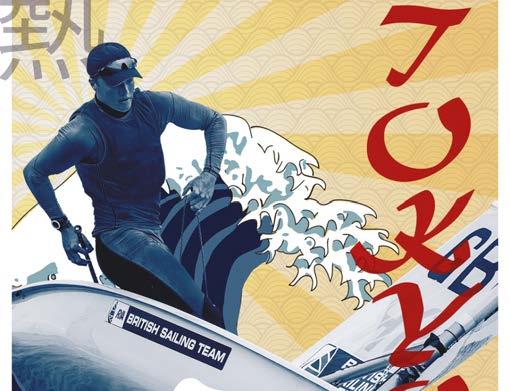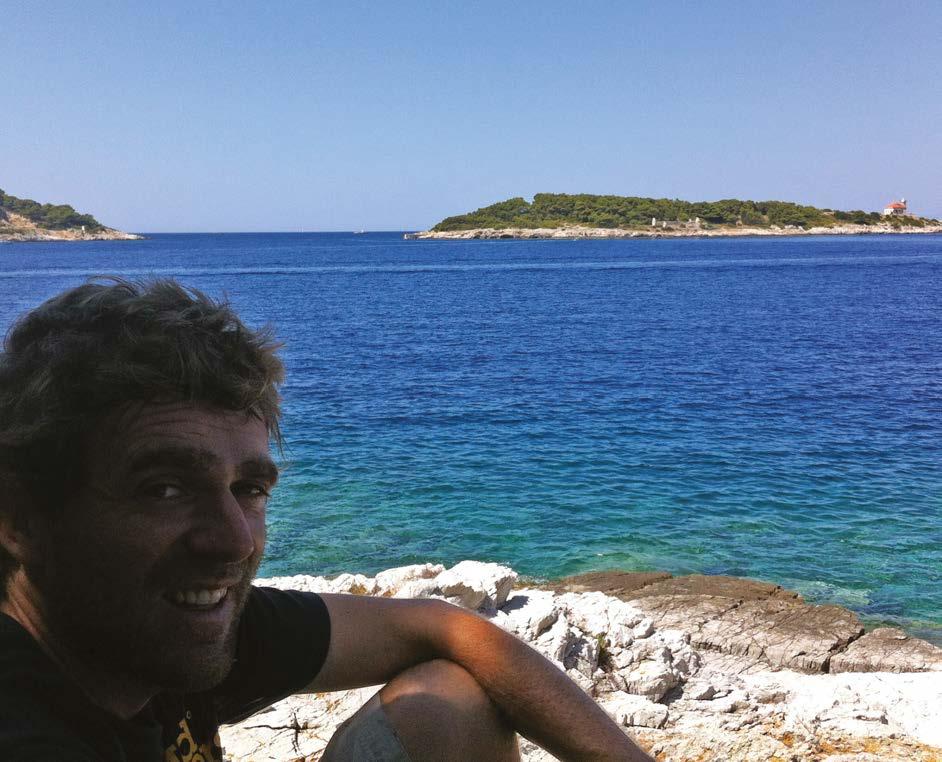
28 minute read
Croatia

Many years ago I spent a couple of summers working as a charter skipper out in Dalmatia. I’d like to tell you that the whole thing was an out of control bacchanal, but I’m afraid I’d be misleading you; I had a nice time but nothing remarkable happened. Nothing?
Well, perhaps that’s misleading. At some point in the months I spent out there, I fell in love; not with a person but with the landscape. the beauty of this coast is savage and wild. Life out here in the summer months is like living with the contrast turned all the way up. It’s a world of vivid blues; lambent waters and deep blue mountains reverberating on the mainland; blinding chalk white shores topped by emerald pines crackling in the heat. It’s an impossibly seductive cocktail.
Sailing tips
Given that you will doubtless be chartering in the summer, there are numerous tips I can give you to improve your experience for sailing in this area. Dalmatia enjoys a hot
Dog days in Dalmatia
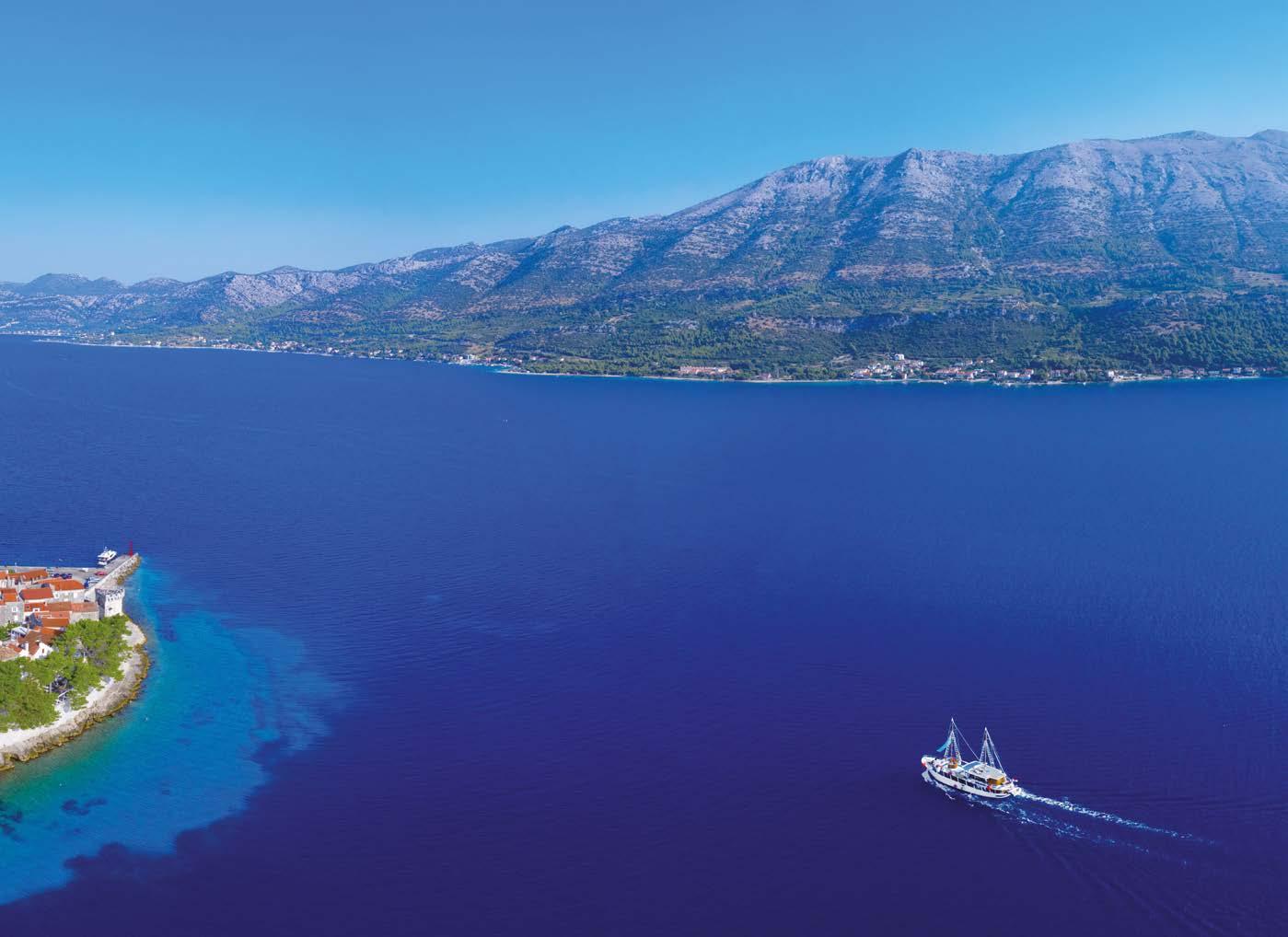
Sam Jefferson recalls the highlights and lowlights of working as a charter skipper on Croatia’s Dalmatian Coast
and generally very settled summer so most days feature beautiful weather and you usually wake up to a sparkling crystal clear morning with very little wind. As a charter skipper, this meant you spent a lot of your time motoring as you generally had a fixed destination to get to by mid afternoon. This was a real shame as the best breeze on offer is generally to be found in the late afternoon when the Maestral, a thermal wind, kicks in. This generally doesn’t really get going until about 2pm but can pick up to 15kn or so and provide some really good sailing conditions. the problem is that - particularly in midsummer - things get incredibly busy so it means that if you want a plumb berth on the quayside of towns such as Korcula or Vis, you are forced to miss out on the good sailing. The good news is that as a private charterer you are not under such pressure and there are an almost infinite number of good anchorages to be found. So my first tip would be to be prepared to anchor off and use the dinghy in the evening rather than get involved in a dog fight for a berth with the many charter skippers. Do be aware though that the Croatian authorities are not shy of charging considerable amounts even to anchor off some of the main ports. If you do choose to go for a berth, be sure to get there early and steer clear of the charter skippers. Things can get quite aggressive in mid season and, unless you are a fiend when it comes to med mooring, you often find that you are squeezed out even as you line up to park (see box out on med mooring for further tips). Aside from that, it’s all pretty much plain sailing. Very occasionally a Bora (very strong northerly wind) will come through and this is usually accompanied by a bit of swell. Keep an eye on the forecast for this. Otherwise, all will be well and you can get on with enjoying Dalmatia.
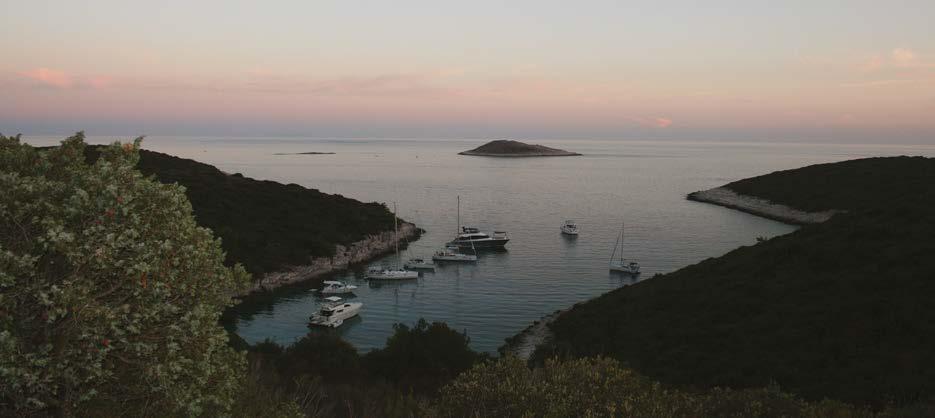
ABOVE
Korcula town is one of the jewels of the Dalmatian Islands
BELOW
A relatively uncrowded anchorage in the Pakleni Islands
Where to go and what to expect
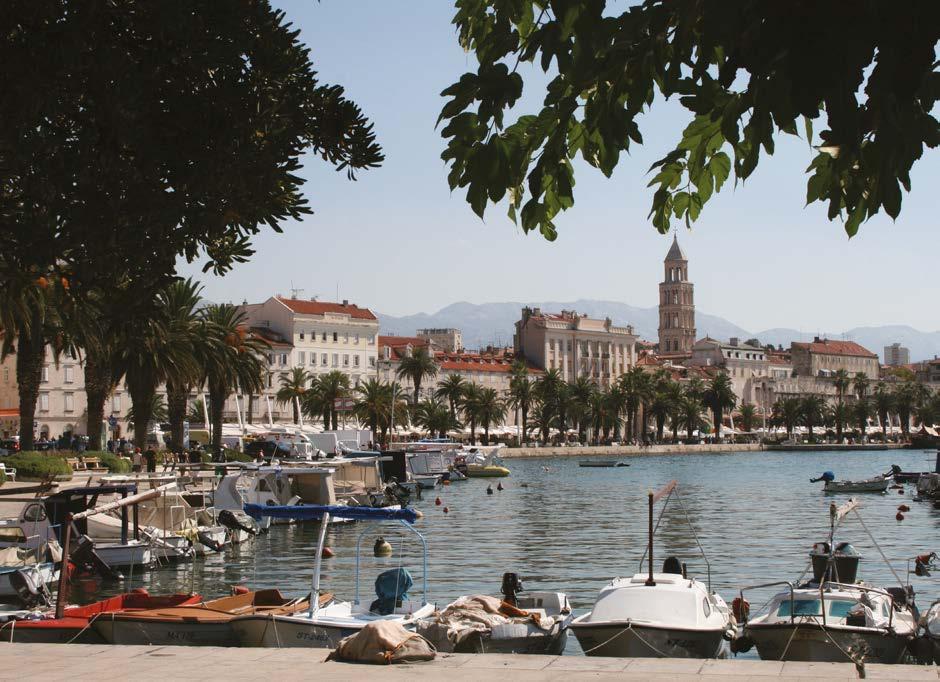
My usual charter route took me from the historic port of Sibenik down past Primosten into the heart of the Dalmatian Islands around Split. The itinerary took in the islands of Vis, Solta, Hvar, Brac and Korcula. These are the islands I am intimate with and can give the best tips on. These are also the islands you are most likely to visit if you take a charter out of Split or Trogir and any of the many marinas around this area. The basic formula is simple enough; there is a liberal scattering of pristine islands with beautiful clear waters peppered with charming villages. Beaches are white pebbly affairs so the, unquestionably the best way to explore multiple islands is by yacht.
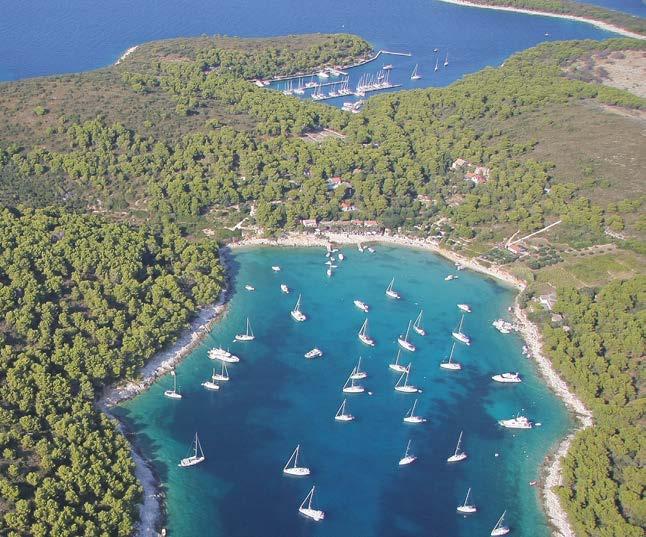

Hvar and Pakleni
Let’s start with Hvar which is something of a honeypot with sailors. Hvar Town itself is heavily marketed as a party town – no idea why as it’s just a charming venetian port with a decent selction of restaurants. Anyway, this is where all partying diehards want to go. It gets so full in summer that most have to moor at the Palmizana marina in the neighbouring Pakleni islands and take a taxi over. From personal experience, I’d say give it a miss. The Dalmatian Islands are crammed with charming Venetian ports so why jostle with lots of boat and human traffic at the busiest? Personally, I was always much more taken with the Pakleni islands and I would generally usher guests off to Hvar and then take a walk from Palmizana along a path that followed the ridge of the island of Sveti Klement – the largest island in the chain. Here you could enjoy real peace and tranquility. A half hour walk brought you to the sleepy village of Vlaka where you could get a cold beer and, with any luck, Konoba Dionis, the small restaurant, would be open and you could enjoy a simple but delicious mean before strolling back in the twilight. Although I was generally obliged to stop at Palmizana for the night, there are innumerable anchorages around the island and most are nice and quiet even in high season.
Anyway, back to Hvar; if I was going to recommend a town to visit, then I’d probably go for Stari Grad,
ABOVE
Split is the biggest city in Dalmatia and is a big charter hub in addition to having a beautiful historic city centre
BELOW RIGHT
Looking down on Palmizana marina, Pakleni Islands
BELOW
A tranquil morning off Stari Grad, Hvar
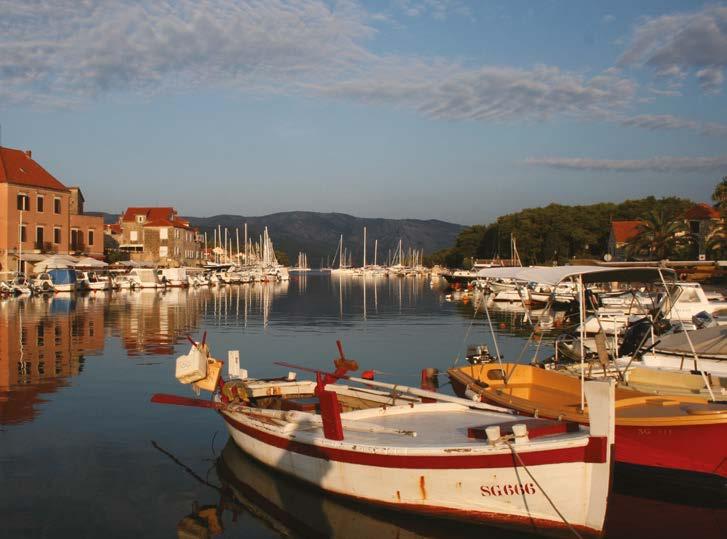
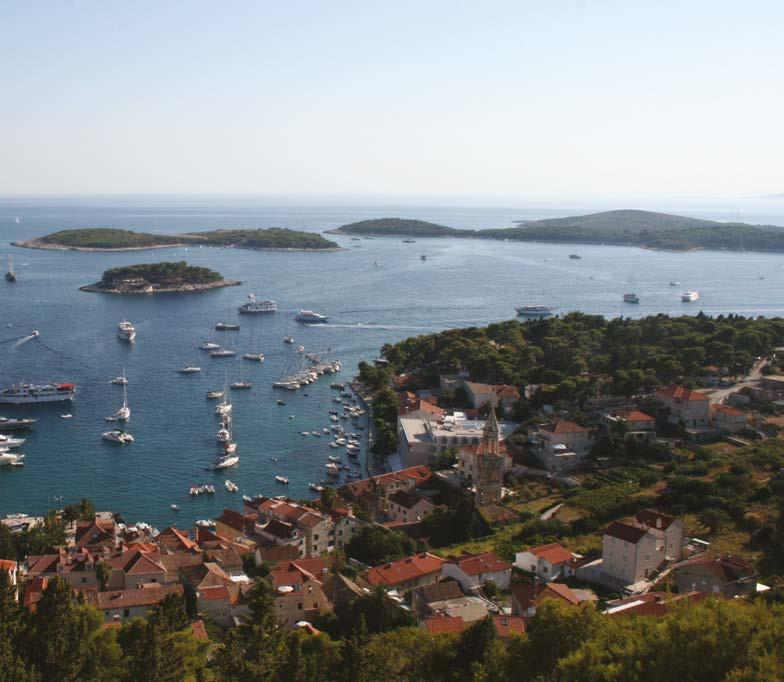
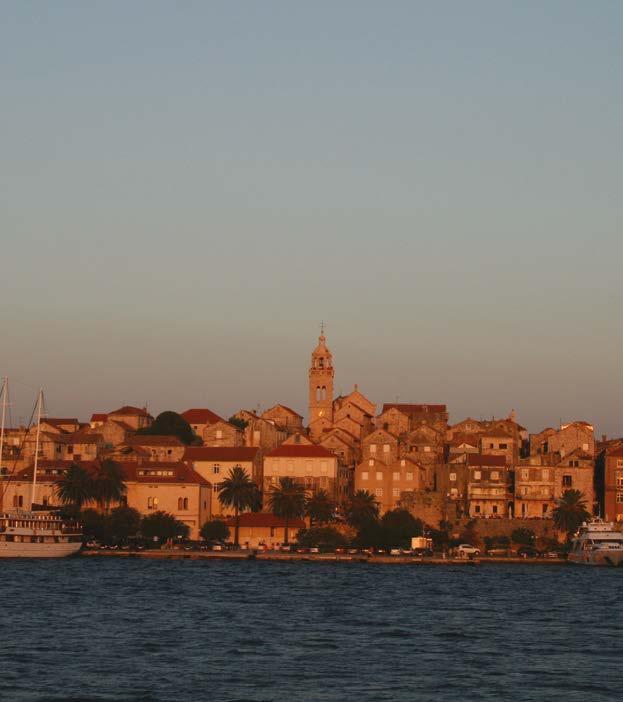
on the eastern tip of Hvar. This is a very ancient town, dating back to 348BC, and one that is just as beautiful as Hvar Town but somewhat less blighted by mass tourism and distinctly more tranquil in August.
Korcula
Korcula Town is one of those iconic spots that often appears on tourist brochures. It’s a pretty walled town – a sort of mini Dubrovnik and claims to have been the birthplace of Marco Polo. There is a marina here and you can moor on the harbour wall. I generally visited by anchoring at a spot called Gradina Bay at the southern tip of the island and taking a taxi down to the town. That sounds like a faff but Gradina Bay is a nice tranquil spot and what you spend on
ABOVE LEFT Looking down on Hvar town
ABOVE RIGHT
Korcula town
Skipper Sam’s Secrets Mooring and anchoring
In ports, Med mooring is king and once you’re used to doing it, there is no problem with this. For the uninitiated it can be a bit daunting, particularly considering how busy things get in midsummer. The key is to act decisively and assertively plus brief your crew well in advance so everyone knows what they are doing. The basic principle is to drop the anchor about three boat lengths ahead of the space you are going to back into. You need to line things up nicely so you don’t get your anchor crossed with the adjacent boat. If it’s breezy, yuo need to reverse at a decent speed to retain control. The best option is to find a spot with a decent sized boat to windward. That way, once you are vaguely in the gap, the boat provides shelter. A boat to leeward aswell is also great as you can lean against this and then have all the time in the world to secure lines and tighten things up. There are lots of nice anchoring spots even in high summer. The depths close in take a bit of getting used to but, other than that, there should be no problem although an electric winch is a real boon.
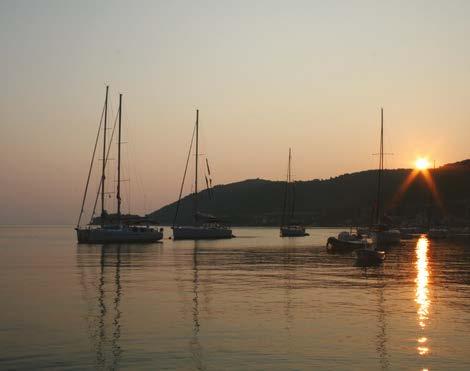
Weather
You can generally expect wall to wall sunshine from April, but things don’t get really balmy until June and until then, the water can be chilly. From hereon, the weather is uniformly clear and sunny right through to September. The coast benefits from being cooler in the evening, so you generally sleep undisturbed. Winds are generally light until the sea breeze, or Maestral, kicks in around midday, when it can build but rarely exceeds 20 knots and dies off in the evening. The only thing to look out for is the Bora. This is a NW wind prevalent in the off season, but one that can still catch out the unsuspecting yachtsman in summer.
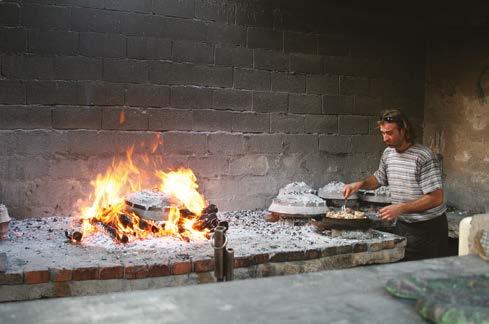
Food and drink
The traditional dish of the area is Peka. I always found the name faintly comical and generally disliked telling guests that they must have some as it could be easily misconstrued. However, the Croatians rightly see nothing amusing about their dish and it is seriously delicious. Essentially, it is a local stew placed in a huge pot which is then buried in hot ashes and stewed for several hours at a time. The meat comes out so succulent and tender that even the boniest goat tastes irresistible. I always felt extremely sorry for any vegetarian guests who missed out on this rare treat. The consolation here was that Croatians also make a mean pizza.
Top fi ve anchorages in Croatia
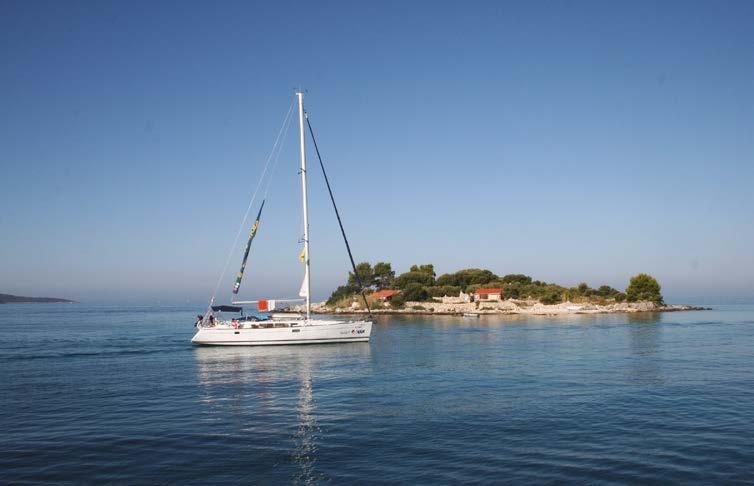
in association with Navily
Sesula, Solta
43° 23’ 34” N, 16° 12’ 36” E
A lovely sheltered cove with a top class restaurant just a few metres away serving delicious Peka. Protection: SW-N Anchoring – allowed Mooring buoys – not available Type of seabed – sand/seaweed/mud
Uvala Gradina, Korcula
Protection: SE-W Anchoring – Allowed Mooring buoys – available Anchor stern to – unavailable Lines Ashore – recommended Type of seabed: Rock
Vlaka, Pakleni Islands
42° 58’ 21” N, 16° 40’ 30” E
A nice bay with beautiful crystal clear waters and a couple of bars ashore (above)
Protection: NW-S Anchoring – allowed Mooring buoys – Available Type of seabed: Sand
43° 10’ 1” N, 16° 21’ 58” E
A good lunchtime stop with and excellent restaurant in the sleepy village of Vlaka.
Protection: E-SW Anchoring – allowed Mooring buoys – 15 Type of seabed: Rock
Uvala Stonica, Vis
43° 4’ 2” N, 16° 11’ 33” E
Extremely well protected anchorage not far from Vis town. Benefi tting from good holding and access to a number of beaches. (below)
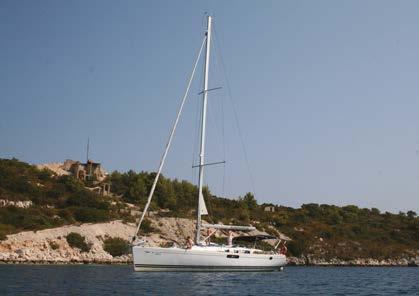
Bobovisca, Brac
43° 21’ 5” N, 16° 27’ 35” E
A decent overnight anchorage in protected weather close to a village with a number of restaurants (below)
Protection: NW-SW Anchoring – allowed Mooring buoys – available Lines ashore – recommended Type of seabed: Rock
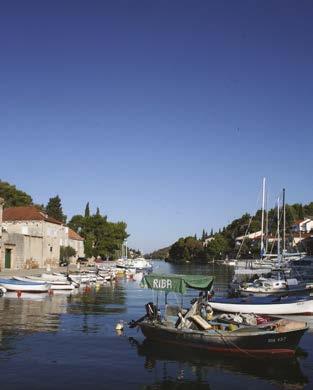

ABOVE
Proizd beach, just off Korcula
BELOW
Vis Town the taxi you save on mooring fees, so it balances out. e other bene t is that Gradina Bay is a couple of kilometres from my favourite anchoring spot in the Dallmatian Islands; Proizd is more of an a ernoon stop o anchorage just o the southern tip of Korcula. It’s essentially a narrow strait between mainland Korcula and the small island of Proizd and I’d imagine if there was much wind or swell it would be a dodgy spot. Sailing through is quite unnerving as the water is so clear you feel certain you must touch the bottom even though there is actually plenty of depth. I used to drop the hook here, prepare lunch and then let the guests go swimming in the limpid water and take a nap while the cooling breeze fanned through the channel. A er that, I can sat back and let myself be soothed into sleep by the lapping water and the rhythmic hum of the cicadas.
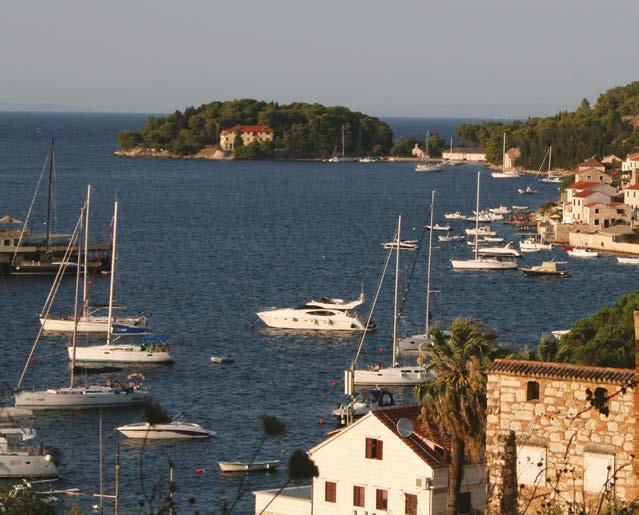
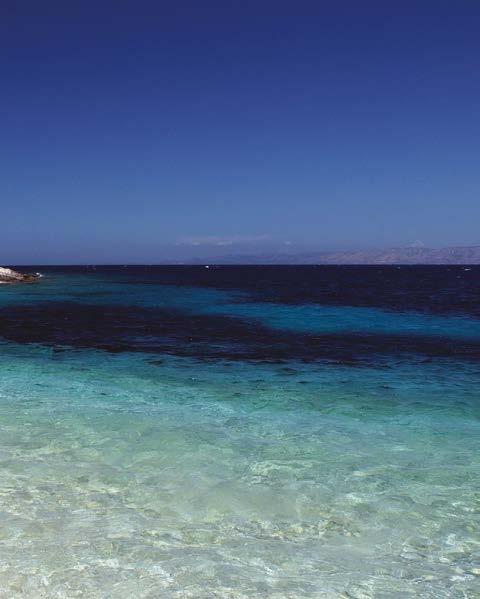
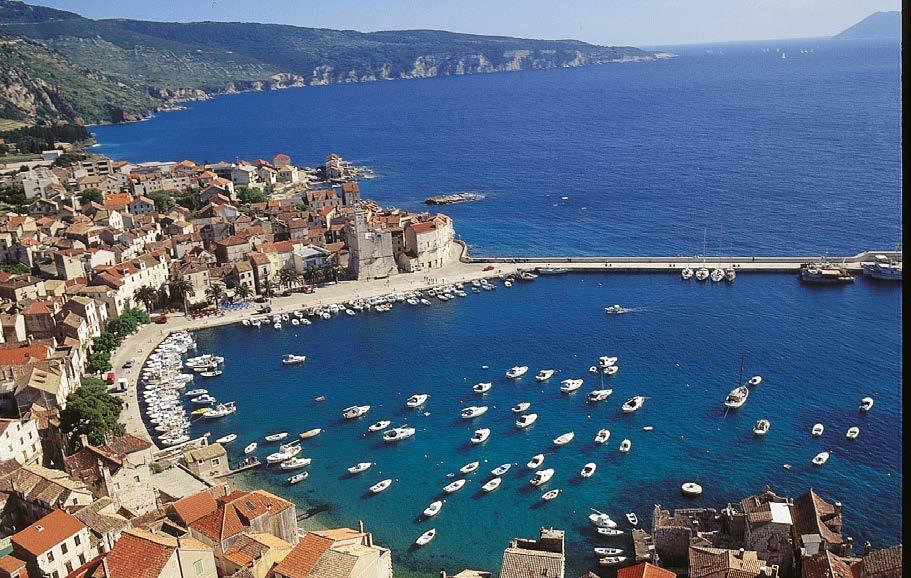
Solta
Solta is an oft overlooked island, the slightly vacant less glamorous sister of Hvar, Korcula, and Vis. The island comprises mostly of splendidly inhospitable rocks and cliffs with few houses. This has ensured it retains a certain raffish charm, particularly if you head inland a bit, where you are soon enveloped in whispering pines and rugged, sunburnt slopes where the cicadas crackle like live electricity from among the rocks.
Brac
Brac is a sleepy companion to neighbouring Solta and there are a handful of peaceful villages. Milna is a decent sized port, but I found it slightly fishy when I was there. The smaller village of Bobovisca just to the north was extremely charming, however. Brac also boasts the only sand beach in the Dalmatian islands; Bol or Zlatni Rat, a striking spit of land with iridescent white sands. Unfortunately, it’s generally a tad busy and, given that having a yacht removes the need for a beach, I’d skip it.
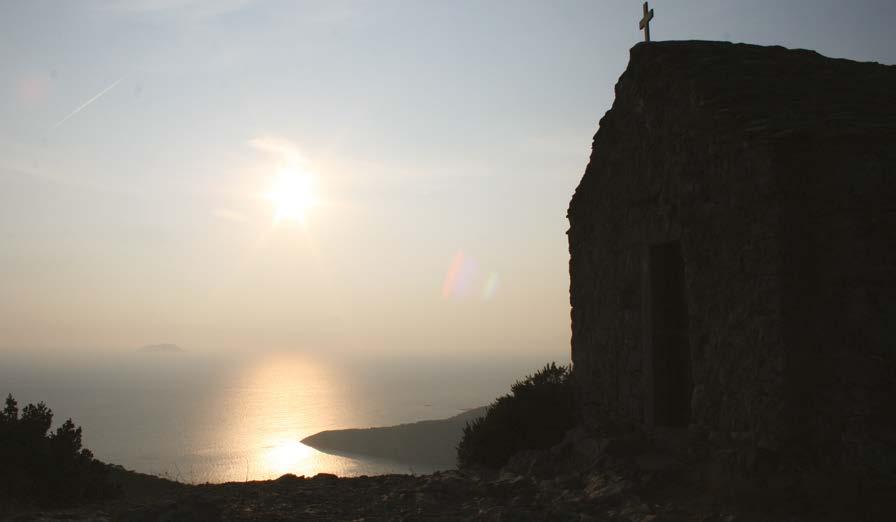
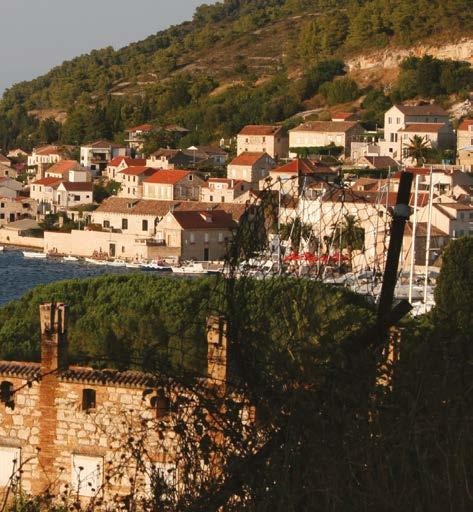
Vis
This was probably my favoured island. In the era of Tito it was a military base and off limits to civilians which has given it a certain crumbling charm mixed with a strange and very Balkan feeling of menace. The main port is Vis Town, which I liked very much – not least because, in my time at least, The Yacht Week had been banned from the harbour wall on grounds of causing a public nuisance. The town is lively but not overrun with tourists and you can take a stroll along the waterfront to Grandovac, a small pebble beach. There is also an excellent anchorage at Rogacic just to the NE of Vis which offers good shelter and holding plus an interesting nuclear submarine
ABOVE
The town of Komiza on the island of Vis
BELOW RIGHT
Looking towards the island of Bisevo from Vis bunker which you can actually moor up alongside and is an interesting relic of Tito’s Yugoslavia. The other decent sized port is Komiza on the eastern side of the island which is similarly picturesque and worth a visit. I can’t say the same of the Blue Cave on neighbouring Bisevo which I always felt were rather hyped and overrun with tourists and tripper boats. If you have a yacht, don’t bother with them is my advice.
Contacts
Click and Boat: clickandboat.com
Dream Yacht Charter:
dreamyachtcharter.com GlobeSailor: theglobesailor.com Helm: helm.yt Sunsail: sunsail.co.uk The Moorings: moorings.co.uk Seafarer: seafarersailing.co.uk
SailGP comes to Plymouth
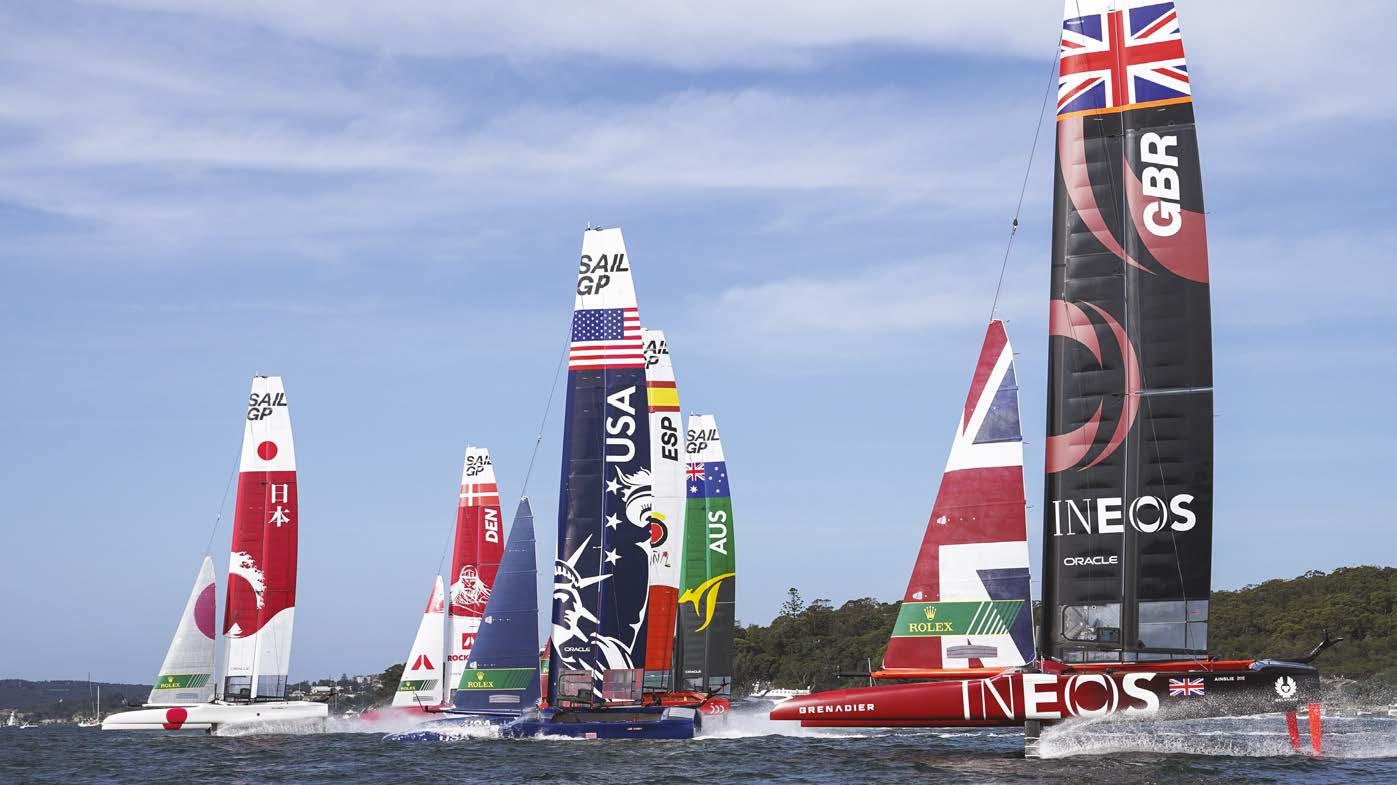
The UK leg of the ground-breaking SailGP championship takes place in Devon, with spectacular vantage points ashore and afloat, as the world’s best sailors go head to head
Plymouth, Devon, will be hosting some of the sport’s best athletes over the weekend of 17-18 July, for the UK event of the global
SailGP Championship – the Great
Britain Sail Grand Prix | Plymouth.
Sir Ben Ainslie will be leading a
Great Britain team against seven other nations including Jimmy
Spithill’s new-look US team, Season 1 champions Australia helmed by Tom
Slingsby and newcomers and
America’s Cup winners Peter Burling and Blair Tuke, among others.
They will be racing supercharged
F50 catamarans – some of the fastest and most innovative sail race boats on the planet and capable of exceeding speeds of 50 knots – nearly 60mph.
The racing will take place on
Plymouth Sound which provides a natural amphitheatre to the adrenaline-fuelled racing. The event, run in partnership with Plymouth
City Council, with support from Associated British Ports, English Cities Fund and Sutton Harbour Group, will also form part of the city’s Mayflower 400 commemorations, marking the anniversary of the signature voyage across the Atlantic Ocean to America.
The Great Britain Sail Grand Prix will be the third event in the league’s global calendar, following the season opener in Bermuda in April and the first-ever Italy Sail Grand Prix in Taranto in June.
The UK event in SailGP Season 1 – which was witnessed by 24,000 spectators and delivered US$24 million in economic impact to the community while reaching a total global audience of 231 million – saw some of the most dramatic scenes of the year. In front of packed crowds, the United States SailGP Team capsized in spectacular fashion and
ABOVE
Season 2 sees eight national teams with mixed crews, as SailGP seeks to ‘fasttrack the inclusion of female athletes’
Inspiring young sailors
SailGP Inspire – the global league’s community, education and outreach initiative – relaunches in Bermuda at season opener with an increased focus on inclusivity and diversity and aims to leave a lasting legacy in all eight grand prix host countries in 2021-22. Launched in 2019 and building on the success of its inaugural season – when 3,000 young people were engaged through the program – SailGP Inspire will focus on providing experiential opportunities and new career pathways to the next generation. Not only will the programme be gender equal, but it will aim to expand racial and socioeconomic diversity in the sport through its three pillars: Learning, Careers and Racing. SailGP Inspire has set a target of reaching 10,000 young people by 2025. For more details visit
SailGP/Inspire
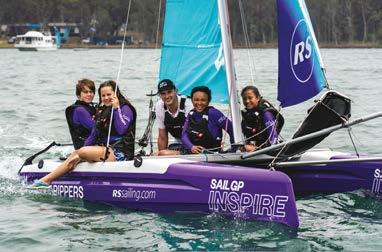
#RaceForTheFuture
In Season 2, not only will SailGP’s eight competitive teams be battling for the championship trophy that comes with the sport’s largest monetary prize, but they will also be racing for a better future and championing a world powered by nature.
As the first climate positive sports and entertainment property – removing more carbon than its footprint – SailGP is already leading the way and setting a new standard for major event hosting. From its inception in 2019, SailGP has been measuring, reducing and offsetting its own carbon footprint and has set an ambitious target of 55 percent reduction of its carbon footprint – based on science – by 2025, as well as committing to being fully powered by nature by 2025. The remaining carbon that cannot be eliminated is offset via a partnership with One Carbon World, directly supporting renewable energy wind projects around the world.
SailGP became a world first in sport to be certified as carbon neutral and achieve both the Carbon Neutral International Standard and join the UN Climate Neutral Now Initiative, reaffirming its commitment to maintain a zero-carbon operational stance.
Further highlighting that SailGP is more than a racing championship, the global league has achieved the international sustainability standard ISO20121 in unprecedented speed ahead of its second season.
A legacy born from the London 2012 Olympics, ISO20121 is a robust sustainable event management system developed to an international standard. New for Season 2, each of the eight national teams will collaborate with a Race for the Future partner to help the sports pinnacle league accelerate the transition to clean energy and work to explore practical clean energy solutions while raising awareness about the challenges of ecological transition geared around clean energy.
This is a central part of the global league’s ambitious purpose agenda to race for a better future and champion a world powered by nature.
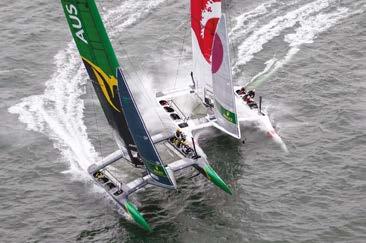
both Great Britain and Australia made history by eclipsing speeds never before seen in sail racing. A renowned sailing venue, Plymouth is expected to bring similar excitement for fans, who will be able to view the thrilling action from the water or shore.
Sir Ben Ainslie said: “For us as a British team there is nothing better than racing in front of a home crowd and we are incredibly excited about the prospect. There is an element of nostalgia for me personally, having grown up and learned to sail in the West Country and now all these years later coming back to race on the international stage. Plymouth is a fantastic sailing venue with a natural amphitheatre for the fans to watch these amazing F50s.”
The Great Britain Sail Grand Prix will be showcased around the world via top-tier broadcasters in 175 territories, including exclusively in the UK and Ireland on Sky Sports and via YouTube
SailGP CEO Sir Russell Coutts said: “We are really excited to add Plymouth as the third event in Season 2 of SailGP. The British have a very talented team led by Ben Ainslie and I’m sure they will receive a lot of local support in their bid for the global championship. Plymouth is a city that shares a lot of the same DNA as SailGP, with a strong focus on marine technology and well aligned with our sustainability
ABOVE AND BELOW
The F50 boats are capable of 50 knots and the racing is spectacular; Ben Ainslie helms the GB boat objectives. It also provides great viewing opportunities for spectators, who can view the racing from an elevated position on Plymouth Hoe. We look forward to working with Plymouth City Council to ensure we leave a positive lasting impression and legacy in the city.”
Pete Smith, deputy leader of Plymouth City Council, said: “We’re absolutely thrilled to welcome one of the world’s most spectacular sailing events to Plymouth – where better to play host than Britain’s Ocean City. It’s going to be an unmissable weekend, with fast and furious racing that spectators can witness up close.”
How to watch
There are a wide range of ticketed experiences at the Great Britain Sail Grand Prix - both on and off the water. Plus ways to get up close with your own boat. Plymouth Hoe provides a spectacular viewpoint to immerse yourself in the high-speed action as the 50-knot foiling catamarans race right before your eyes within the natural amphitheatre of Plymouth Sound. Ticketed free access to the Spectator Area includes live race commentary, big screens, the official merchandise shop, entertainment, immersive experiences, refreshments, stage and podium with athlete appearances. There is also a Premium spectator experience a little closer to the action with refreshments. For those wishing to get even closer to the action there will be two on-water spectator experiences - Premium and Access. Official spectator boats will offer the closest vantage point to the racing and allow fans an unrivalled view of the world-class athletes and supercharged F50 catamarans as they compete at electrifying speeds across Plymouth Sound.
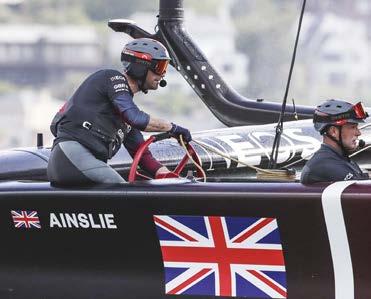
Finally, for those that have their own boat, there is a Bring Your Own Boat programme - a simple registration ensures you have all of the latest information about the race course and live commentary to ensure you get in the best spot for racing and don’t miss a moment of the action.
Book the 17-18 July, 2021 in your diary and don’t miss any of the action.
For more information on SailGP Season 2 teams and schedule, the Plymouth event, the SailGP Inspire programme, tickets and more visit the website SailGP.com/GreatBritain and keep up to date by signing up to the newsletter, you can also download the App and follow the Facebook page
Facebook.com/SailGP
For all the information on the event, check out SailGP.com/GreatBritain. Don’t forget to sign-up to our newsletter or follow us on social media to ensure you don’t miss a minute of the action.
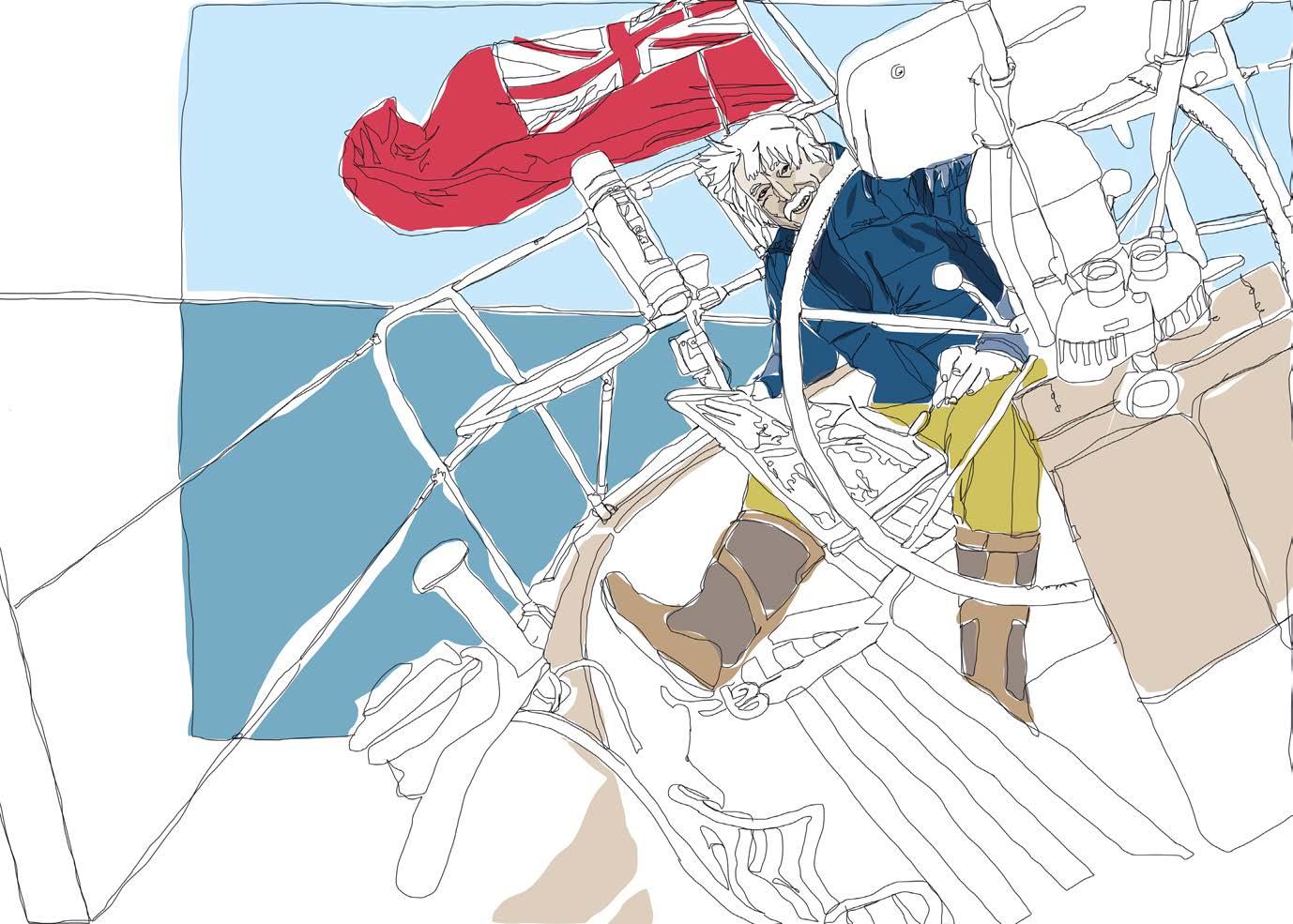
Tom Cunliffe
A soujourn in the swamps of America’s deep south gave Tom pause for thought on the fraught question of selecting the right boat to buy
Last week during a Q&A Zoom session organised by MDL Marinas I was asked about what sort of boat to buy. The question was quite specific and I’ll return to it shortly, but it triggered off some general thoughts about how the rest of us choose suitable yachts to ward off the hard knocks of life.
My wife and I were once marooned up a muddy creek in America’s deep south. I was recovering from a damaged rib cage left over from a nasty night off Cuba. Funds were tight and the local yard proved a bountiful haven. Spanish Moss festooned the live oaks overhanging the water and to say that the denizens of the river bank were a sparky bunch would be an understatement, but among their number were notable examples of how, and how not, to pick the right boat.
As the sweltering weeks passed and I grew slowly stronger, we subsisted on crabs harvested from a pot dangling off our stern donated by the lady skipper of a neighbouring shrimp boat. Close by was a genuine Tumlare. Aboard this pencil-thin, 28ft, 1930s Scandinavian race boat lived a girl with her boyfriend. He was the yard engineer and he had a southern accent that blew Johnny Cash into the reeds. One morning, I met her clambering ashore sporting a teeshirt emblazoned with a strong message. ‘Isn’t this a lovely day,’
PODCAST
Catch up with Tom’s columns now and in the future at sailingtoday.co.uk
ILLUSTRATION: CLAIRE WOOD, PHOTOS TOM CUNLIFFE
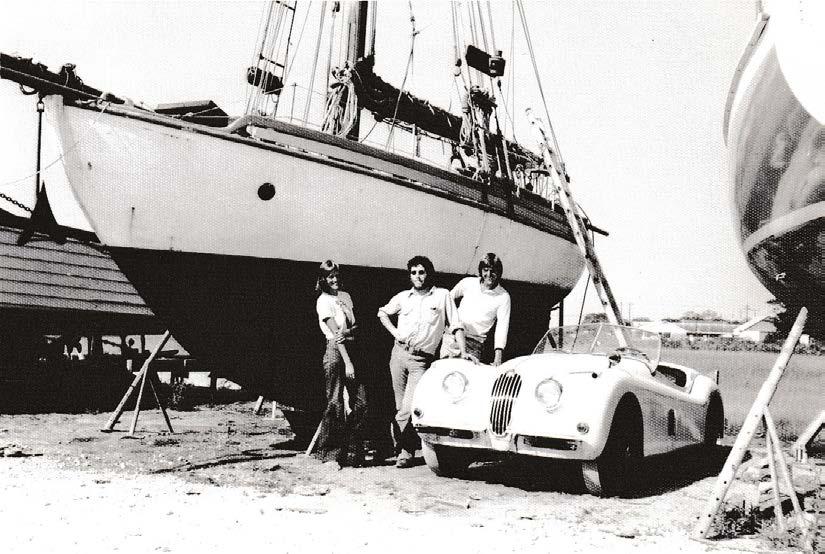
it read. ‘Now watch some bastard louse it up.’ Time has taught me that this prophesy contains more than the seeds of truth, but she was a sweet-natured soul and I’ve often pondered on how the young couple survived on so inappropriate a yacht. The Tumlare was beautiful, probably cheap too in a land where nobody understood it, and they were in love. I suppose they didn’t care, but you did have to wonder how they coped in a home whose beam was an inch or two over six feet, designed for day racing and occasional overnight camping in the Stockholm Archipelago. The truth was that they put up with the discomfort because of how she sailed and they were always smiling.
Further up the creek lay the ultimate dreamer living in a fantasy world. Ambrosio was a sort of heavy-displacement hippy with a mighty blond beard and no comb. One evening shortly before cocktail time I was wandering back to my boat after a day’s toil varnishing someone else’s pride and joy when Ambrosio decided to give Coleridge’s Ancient Mariner a run for his money. He’d made inroads into a bottle of rum and, as always, he delivered his message at Force Ten. Just as if I were Coleridge’s reluctant wedding guest, he grabbed me by the arm and began extolling the ocean-going virtues of the long-since pensioned off charter boat he had claimed as his own from some scrap yard.
‘Man,’ he bragged, ‘this boat is so goddamn strong you could sail her round the world tomorrow!’ For emphasis, he took hold of his rusty forestay and rattled it with gusto. It fell apart in his hands. His girl, who had the reddest hair I ever saw, spun on her down-at-heel sneaker and marched off in the direction of Blackie, a proper southern gent with well-trimmed side whiskers who had been burning off a classic Chris Craft powerboat for weeks after he knocked off from work. Blackie always had a six-pack in his pickup truck and he had a generous heart. The roar of his old-fashioned paraffin blowlamp fell silent and I heard two pop-tops fizz. Ambrosio meanwhile offered me the ragged ends of his rotten forestay.
‘You reckon they’d splice up?’ he asked, to which there just wasn’t a kind answer.
There were other characters in that yard, but these epitomised getting it right, getting it wrong, and coping as best one can. The Tumlare folk loved their little boat, they couldn’t afford more but they maintained her with genuine pride in a job worth doing. They’d made something special out of an impossible situation and when they went sailing at the weekend, the boat ate the wind out of almost everything on the water. The thrill they shared as she’d get up and go made it all worthwhile. I expect
ABOVE
Tom’s boat hauled out in Carolina with a visitor showing her some decent respect
BELOW
The Tumlare ‘on the hill’ for a topside job
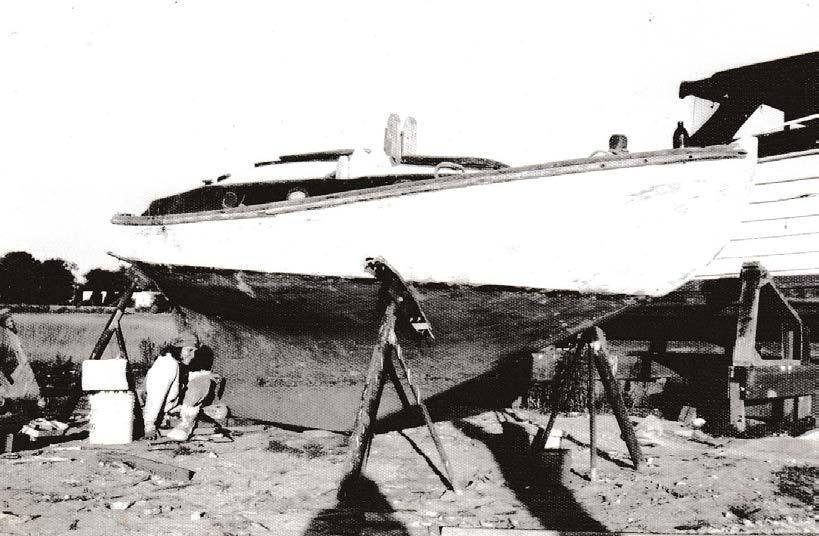
by now they have prospered and have a more appropriate craft, but they will remember their youth and be glad they followed their dream into the wind’s eye.
Ambrosio was a hopeless case. I never got to the bottom of whether he really did plan to sail around the world or if he just maintained the fantasy, fooling himself perhaps, but certainly nobody else. He’d come by a boat that was far bigger than he could afford to bring up to standard and he’d no taste for work. Rather than decide what he actually needed, then find something more appropriate, he’d turned his back on reality and retreated into make-believe.
Even after all these years, I still look back on Blackie with affection and admiration. He never seemed to think badly of anyone, he was everready with a cold beer for people who needed a chat, and he grafted away quietly on a boat that was well worth the trouble. Goodness knows what he paid for her. Not much, I suspect, because she was in a sorry state, but she was a class act and he was cutting straight to the chase on the restoration. No messing around for Blackie. He ripped into it with every spare second he had and he was going to end up with a power cruiser to be proud of. When I asked what he’d do with her, he told me he planned to enjoy the waterways and the primordial cypress swamps of South Carolina,
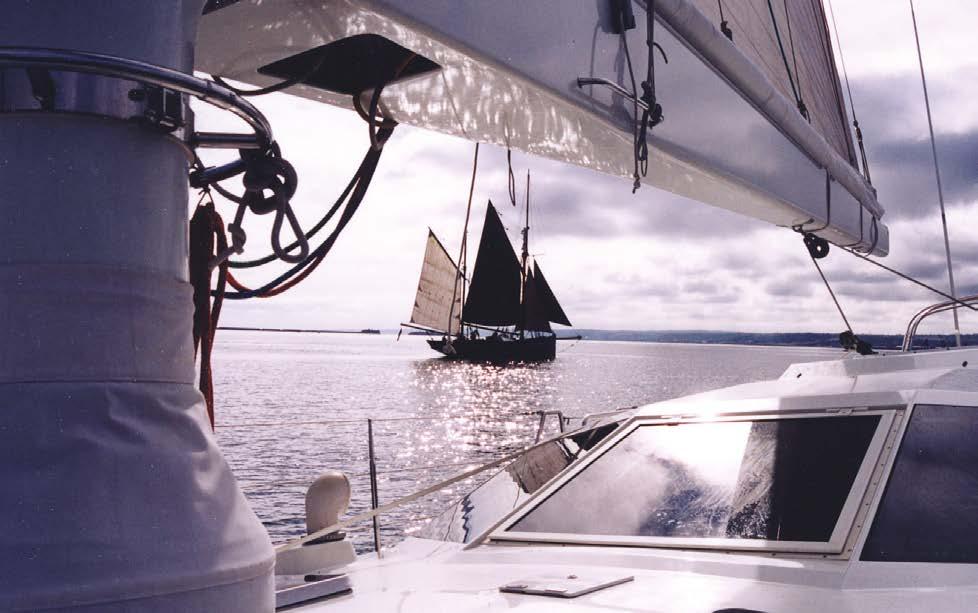
ABOVE
Some choice - a modern carbon rig ghosts past a gaffer outward bound for high adventure
TOM CUNLIFFE
Tom has been mate on a merchant ship, run yachts for gentlemen, operated charter boats, delivered, raced and taught. He writes the pilot for the English Channel, a complete set of cruising text books and runs his own internet club for sailors worldwide at tomcunliffe.com and to have what he described in his catch-phrase as, ‘Fun, fun fun!’ By defining his objectives honestly, Blackie had satisfied the first axiom of successful boat ownership.
Such exotic creatures as these seem a world away from a young lady in southern England asking for guidance about what boat to buy, but the rules don’t change. The question she posed was interesting. She’d made a good start by deciding what she wanted to do. She’d set out two further parameters. One made complete sense, the second was also useful, but the third was doing her choice no favours at all.
The boat could cost up to £50,000. This, I’m sure you will agree, is a tidy sum and it establishes the limits on the major issue of cost. Whatever one fancies in the way of boats, the chosen one always seems to be overbudget. Even if you aren’t, you’re still going to need some extra for the inevitable upgrades. Occasionally, it’s best to toss your fate and your bank balance to the wind and go for it, but unless you are young and footloose, penury rarely leads to happiness. The better option is to forget her and go back to Apollo Duck.
The second criterion was that the yacht must be a bilge keeler because this made the lady feel safer in tight waters. I can understand that, but the third requirement really rocked the boat. The door was open for taking off round the world later, so buying up front conferred a chance to get to know her. That sounds rational, but it isn’t really. Very few sailors given the option would opt for a bilge keeler as an ocean passagemaker, but some lovely bilge-keel variants are on offer for half the funds she has available. Why not forget the big plan that might never happen, and grab a Westerly Fulmar to enjoy for a year or three in the Solent? These boats sail well, a decent example is only half her budget and it ticks all the boxes. Our girl can then ringfence the balance and see how she gets on. If the world trip firms up, sell the Fulmar and invest the full amount in a deep-keeled cruiser ‘of a certain age’. That way she’ll have the right boat at the right time.
Whether we’re fixing up a wreck like Blackie or commissioning a custom new-build, our only hope of bringing our dreams to a safe haven is to take a long hard look at our objectives in the free air of self-knowledge. Whatever our plans, there are some wonderful boats out there.



